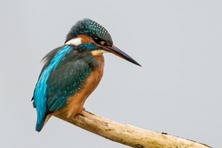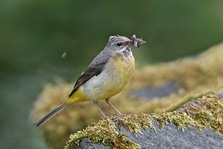

Biodiversity
Action
Plan
Birds of running and standing water
A range of bird species associated with water bodies breed in Barnsley. Of these three are Local Priority Species: Kingfisher, Grey Wagtail and Pochard.
The UK Water and Wetland Breeding bird populations indicator includes Coot, Dipper, Goosander, Great Crested Grebe, Little Grebe, Grey Heron, Kingfisher, Sand Martin, Mallard, Moorhen, Common Sandpiper, Tufted Duck and Grey Wagtail.
Grey Wagtail has grey upper parts but a yellow under-tail and chest, - and a long tail.
It feeds on midges and other insects near running water in upland areas and where weirs and spillways increase the flow in lowland waters.
In Barnsley there has been an increase in numbers, with up to 80 pairs, against the trend.
Grey wagtail nests near flowing streams, in hollows, holes and crevices within rocks, tree roots or built structures.
Grey Wagtails breed from March with two to three broods.
Reasons for national declines are not known but linked to their habitat. Water quality and insect abundance are possible factors.
Grey Wagtail
BoCC5 Amber List [IUNC2 NT]
General protection W&C Act
Kingfishers, bright blue, orange birds, fly rapidly, low over water, and hunt fish from riverside perches, diving into the water!
They feed on small fish and aquatic invertebrates.
It is a scarce and localised breeding bird in Barnsley, with less than 25 breeding pairs.
Conservation measures
- Improving water quality
- Maintaining small fish stocks
- Returning rivers and streams to more natural forms
- Retaining steep banks with suitable cover
- Preventing disturbance and harm to bank structures
Habitats
- Running & standing water
Kingfishers excavate a nest burrow, up to a metre deep, in a vertical stream bank,.
2-3 broods are raised from April to August.
Threats include
- inadequate fish numbers
- water quality and pollution
- disturbance
- harmful bank management
- poor winter survival rates.
Kingfisher
BoCC5 Green List prev Amber, [IUNC2 VU]
Schedule 1 W&C Act protection
Pochard: males have a bright reddish-brown head, black breast and tail and pale grey body. Females are brown with a greyish body.
Pochard is a diving duck and feeds on plant materials, snails and other aquatic invertebrates below the water's surface.
Rare as a breeding bird, and localised, there may be up to four breeding pairs in the lower Dearne Valley.
Conservation measures
- Maintaining lowland water bodies and wetlands with adequate vegetation
- Restricting access to reduce disturbance
Habitats
- Well vegetated water bodies and wetlands
Its nest, a shallow cup of plant material lined with down, is on the ground or on floating mats of plant material, concealed in thick vegetation.
It requires undisturbed, well vegetated water bodies and wetlands for breeding and has has just one brood.
Pochard populations have declined rapidly due perhaps to:
- Lack of habitat for breeding
- Predation and disturbance.
Pochard
UKBAP 2007 Priority Species
NERC Section 41 Species of Principal Importance
BoCC5 Red List [IUNC VU]
General protection W&C Act
Conservation measures
- Retaining running water habitats
- Maintaining water quality to support insect food
Habitats
- Running Water: rivers and streams
Other breeding birds associated with running and standing water include:
Schedule 1, Amber: Garganey, Mediterranean Gull
Amber: Gadwall, Mallard, Shoveler, Teal, Moorhen, Common Sandpiper, Common Tern, and Black-headed Gull, Common Gull and Lesser Black-backed Gull,
Green: Coot, Great Crested Grebe, Little Grebe, Grey Heron, Little Egret, , Mute Swan, Sand Martin, Tufted Duck



Birds of running and standing water